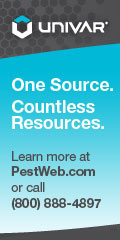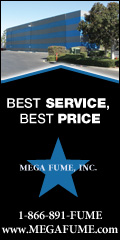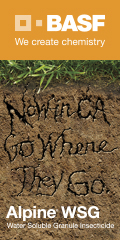
| August 2015 | Past Issues | Printer-Friendly | Advertise | Affiliates Search | Find a Pest Control Operator | PCOC.org |
|
EVP NOTES
 Almost every profession that requires exams or continuing
education has a study guide that allows aspirants to that profession to prepare
for the test. You would think this is common sense. In fact, every licensing
Board within the Department of Consumer Affairs has a study guide for the same
purpose. That is every Board except one: the Structural Pest Control Board. Almost every profession that requires exams or continuing
education has a study guide that allows aspirants to that profession to prepare
for the test. You would think this is common sense. In fact, every licensing
Board within the Department of Consumer Affairs has a study guide for the same
purpose. That is every Board except one: the Structural Pest Control Board.
Why, you may well ask, do we not have a study guide? Those of you who have been around a long time may remember a time when PCOC developed a study guide. A great idea...except we were then told to cease and desist because it encouraged cheating on the tests! So there has been no study guides available for those potential employees of the pest control industry in California who want to prepare to enter our profession. The good news is: that’s all about to change. This has all come to a head as a result of the pass rate plummeting and the desperate need for relevant questions on the tests themselves. PCOC, in meetings with Board staff and at presentations to the Board, has been forging ahead in the development of a study guide for all three branches. Our PCOC Board of Directors have given the green light to proceed. We have set up three taskforces to develop the material. At the last SPCB meeting, legal counsel made a finding that there was no impediment to a study guide being produced as long as it didn’t compromise the test. This is significant because it now gives PCOC the protection we need to produce a study guide. Good things are in the works! Stay tuned on this important issue...... LEGISLATIVE UPDATE
IN THE NEWS
On July 1, California Department of Pesticide Regulation (DPR) put into place a number of new rules for Personal Protective Equipment for pesticide handlers. DPR states that the "regulatory action clarifies the personal protective equipment (PPE) requirements, reducing ambiguity, and reorganizes the regulatory requirements in a more logically cohesive format." The two main areas of focus are on eye protection and gloves. Eye Protection In the adoption of CCR 6738.2, DPR clarifies what is acceptable eye protection by implementing a Federal standard as its standard. This requirement, ANSI Z87.1 (American National Standards Institute), is recognized as the authority on eye protection. For California, that means if eye wear is required, but no type is specified on the label, whether safety glasses, goggles, or face shield, they are to be marked with Z87.1 or just Z87. Most eye glasses have been designed and manufactured to meet this standard and have a Z87 mark on the frame and/or the lenses. Employers still need to make sure glasses fit employees properly. Gloves In regards to gloves, DPR wanted to be aligned with U.S. Environmental Protection Agency (EPA) guidelines. There are three main changes through the adoption of CCR section 6738.3. 1) Glove Liners: DPR’s new rule now allows the use of "separable" glove liners under chemical resistant gloves. These liners are separate gloves. The use of lined for flocked gloves in still prohibited. These liners are to be made of cotton or other absorbent materials and cannot stick out past the end of the chemical resistant glove. The liners are to be disposed of at the end of each day or immediately removed and thrown away if they come into contact with any pesticide The use of these liners is believed to encourage employees to wear their chemical resistant gloves in either the heat, when hands get sweaty, or the cold to add a layer of insulation. 2) When chemical resistant gloves are used to make fine adjustments to equipment or other activities requiring high dexterity and motor control not offered by thicker gloves, thinner gloves such as nitrile gloves may be used. These gloves must be compliant with the pesticide used and can only be used for a maximum of 15 minutes after which they must be discarded and not reused. 14 Mil or thicker gloves must still be used for normal handling activities. 3) DPR has developed a Glove Category Selection Key. There are categories from A-H listing what gloves materials offering the greatest level of chemical resistance to those materials used in that pesticide formulation. The categories are based on the solvents used in the pesticides, NOT the pesticides themselves. If the barrier material is specified by category on the product label, the required glove must be used as specified in the chart. There may be instances where the same pesticide has two different formulations (wettable powder vs. an emulsifiable concentrate) that may require a different glove material for each formulation. A Glove Category Selection Key card can be obtained from your local ag commissioner or by contacting the DPR, Worker Health and Safety Branch, Industrial Hygiene Services at 916-445-4211. You can also look at the following links for charts and other information: http://www.cdpr.ca.gov/docs/whs/pdf/glove_card.pdf http://www.cdpr.ca.gov/docs/legbills/calcode/030302.htm The below link has a list of solvent (chemical or trade name) along with what category it is in on page 11: http://www2.epa.gov/sites/production/files/2014-07/documents/chapter10-final-fd-jr.pdf UPCOMING EVENTS
2015
Board of Directors Meeting — September 25- 26, 2015
Catamaran Resort — San Diego Golf Tournament Registration Hotel Registration BOD Agenda Board of Directors Meeting — December 11-12, 2015 Palm Springs Hilton — Palm Springs, Calif. Pestech 3.0 — January 5-7, 2016 San Jose Marriot- San Jose, Calif. NPMA Event Registration Comings and Goings
Welcome to a new section of Newsbriefs! Here, we will give news from our members: new hires, retirements, etc. If you have some news you would like to share, please send a short sentence or two to breann@pcoc.org. MEMBER NEWS
MEMBER VALUE PROGRAM
PCOC MONTHLY INSURANCE/SAFETY TIP
The Benefits of Structured Settlements Once a worker suffers an occupational injury while working for you, he or she becomes your responsibility for life. If the injury recurs or flares up, the employer remains responsible for providing the necessary medical treatment. This holds true even years after a relatively minor accident. Some workers’ compensation claims remain open for years, or even decades. Using a structured settlement can help both your organization and the injured employee move forward. Structured settlements generally come into play when an injured worker ends up suing the employer for additional amounts or for a subsequent injury. Under a structured settlement, the claimant generally agrees to stop any legal action. In return, he or she receives a settlement payment from the defendant — in this case, the employer. This releases the employer from future obligations for that particular injury. This avoids a long, drawn-out court case and allows both the employer and employee to move on. When a plaintiff receives a settlement, it can come in the form of a lump sum or as a structured settlement. With a structured settlement, the plaintiff receives periodic scheduled payments. Payments can last for a year, for the claimant’s lifetime or somewhere in between. When an organization and employee agree to a structured settlement, they will generally use a structured settlement broker. An experienced broker can help you negotiate the terms of the agreement and arrange funding. Structured settlements generally are funded by a single-premium annuity contract held by the employer. A lump-sum payment will often count toward taxable income. With a large lump sum, taxes could take a considerable percentage. Structured settlements may have some tax advantages Structured settlements offer the following advantages: ·They
release employers from future obligations. Both the employer and employee can
move on.
·They
provide a continuing stream of income to injury victims. This minimizes the
risk that injured workers will spend away their claims proceeds and run out of
money.
·They can provide injured workers a tax-free source of income. Lump-sum payments are often considered taxable income. If a worker receives a large lump-sum payment, taxes will take a considerable chunk of it. ·They typically prohibit the claimant from assigning or transferring his/her rights to receive future payments. This helps prevent fraud, embezzlement and running out of funds. For more information on using structured settlements, please contact the PCOC Insurance Program department of EPIC at (877) 860-7378 or, email us @ ProPest@epicbrokers.com. Also check out: www.pcocinsurance.com. NEW MEMBERS
FREQUENTLY REQUESTED INFORMATION
NPMA LOGIN FOR JOINT MEMBERSHIP LOGIN: 313501 PASSWORD: PCOC
Department of Food & Agriculture Department of Pesticide Regulation (DPR)
www.cdpr.ca.gov DPR on Facebook www.facebook.com/capesticideregulation DPR on YouTube (see "playlists" for videos pertaining to new surface water regulations) www.youtube.com/user/californiapesticides DPR on Twitter twitter.com/ca_pesticides DPR LinkedIn www.linkedin.com/company/california-department-of-pesticide-regulation Healthy Schools Act http://apps.cdpr.ca.gov/schoolipm/ Structural Pest Control Board www.pestboard.ca.gov Find Your Legislator |
Pest Control Operators of California |
 |






